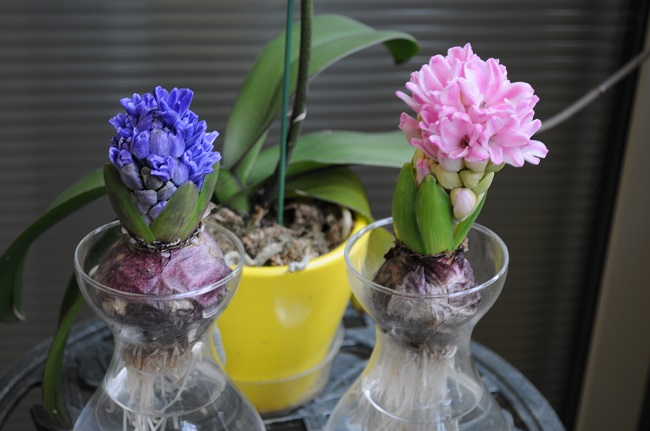Looking around outside there are rich hues on the trees and in the flower beds. Cranberry, golden and brown colored leaves are dropping to the ground. Mums in shades of crimson, white, cinnamon and goldenrod are on everyone’s front doorsteps. Pumpkins are soon ready to pick and fill the fields beside the highways as you drive to work. While it is beautiful outside, remember that February is coming. That is a time of year when there is virtually no color outside when you live in the North. You look out the window and everything is gray, black, and brown with only a little green from evergreens and holly trees.

Now is the time to start forcing your bulbs so you can have a burst of color during February. There are numerous kinds of bulbs to force and several methods of doing so.
Using a Container
The most common way is to plant bulbs in a flowerpot filled with potting soil. Daffodils and tulips are the most common bulb to force in the ground. A shallow flowerpot will suffice, simply fill it with potting soil, plant your bulbs and then cover them with more soil and water.
The container cannot be kept in a warm room; it must go to an unheated space. Most homeowners use an unheated greenhouse, a root cellar, basement, or garage. You want to keep the containers cool for the duration of the winter as you are trying to mimic nature. The container should remain in absolute darkness like a bulb planted outside in the ground and do not overwater the container because the bulbs will rot. A few waterings each winter will suffice. The best thing to do is to forget about the bulbs and leave them on their own.
Set a reminder on your cell phone or calendar for January. Each week check the bulbs and you will see them beginning to break the surface of the soil. When you see green (or sometimes very white) stems poking the surface, it is time to move the container to daylight. This helps mimic early spring when the bulbs begin to grow. Transfer the container to a sunny windowsill that is in a relatively cool location. If you bring the container into the heated home the bulbs may grow too quickly and die or never produce a bloom. Begin to consistently water the new plants, adding a diluted fertilizer will help as well. By the time February comes you will have blooms and color on your windowsills.
Using Water Instead of Soil
Another method for forcing bulbs is to use water instead of soil. This is less common but still a great experiment for a gardener. Daffodils do very well with water forcing. Instead of planting the bulbs in soil, fill half of a saucer with gravel. Place the bulbs on top of the gravel and fill with water up to the bottom of the bulbs. Do not go any higher on the bulbs or they will rot. Here again you need to keep the bulbs in a dark location, but you also need to keep your eye on the water level. The saucer should always have some water in it. This technique requires more maintenance and is trickier to sustain. In my own greenhouse, some of the bulbs have developed mold but your luck may be better than mine. When the bulbs start to grow a leaf, bring them to sunshine and proceed as normal until they bloom.
Easy Bulbs for Starters
My favorite bulb to force in water is a hyacinth because it is so easy to complete. There are specialized forcing vases on the market to use with hyacinths that have a rounded cup at the top which holds the bulb while the bottom is filled with water. You can also force the bulb with a regular vase, or a gravel filled saucer. The key is to have the water touch only the very bottom of the bulb. A vase or forcing vase is often preferred because you can watch the roots develop and grow inside the water. Keep in mind that prolonged exposure to sunlight will create algae in the water so the bulb needs constant darkness. It has been my experience that the hyacinth blooms before other bulbs so you may see the start of a plant in December. After the green shoot has sprouted, bring it to daylight and keep it watered.
Another easy water option is an amaryllis bulb. Amaryllis are beautiful in winter. They typically bloom around December and are normally white, pink, or burgundy. I like to buy the bulbs when they go on clearance after the holidays and then proceed to force them into bloom. I put the large bulbs in a flower vase filled with gravel and water which only touches the bottom of the bulb. The difference is that with the amaryllis I do not keep it in the dark. They grow in an unheated greenhouse, but in natural daylight. You can also force an amaryllis into bloom by growing it in soil. If you pick this manner the amaryllis does not need a large container. I use a 4-6” pot for each bulb.
When any of the plants bloom, using a cooler environment will make the blooms last longer. A room around fifty degrees will prolong the length of the bloom far longer than a room that is seventy degrees. After your bulbs bloom, they are often dead because forcing them to bloom creates too much stress on the plant to re-use it again the following year. It is not impossible to make the same bulb bloom again, but it typically does not produce as large or bright a flower the second time. The exception to the rule is the amaryllis. Following a bloom, the stalk is removed, and the bulb remains on the gravel, or in soil, for several months until it grows again. September and October is the time to start the bulbs into forcing.
Lyndsey Roth is an experienced gardener and greenhouse grower.
Related Articles & Free Email Newsletter Sign Up
How to Grow Pineapple in a Greenhouse
How to Propagate Super Succulents



Comment here